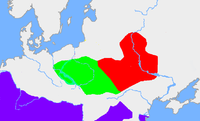
Back Zaroebintsi-kultuur Afrikaans Зарубінецкая культура Byelorussian Зарубінецкая культура BE-X-OLD Zarubiněcká kultura Czech Sarubinzy-Kultur German Culture de Tsaroubintsy French Զարուբինեցյան մշակույթ Armenian Cultura di Zarubynci Italian ザルビンツィ文化 Japanese ზარუბინეცის კულტურა Georgian


The Zarubintsy, Zarubyntsi or Zarubinets culture was a culture that, from the 3rd century BC until the 1st century AD, flourished in the area north of the Black Sea along the upper and middle Dnieper and Pripyat Rivers, stretching west towards the Southern Bug river. Zarubintsy sites were particularly dense between the Rivers Desna and Ros as well as along the Pripyat river. It was identified around 1899 by the Czech-Ukrainian archaeologist Vikentiy Khvoyka and is now attested by about 500 sites. The culture was named after finds of cremated remains in the village of Zarubyntsi on the Dnieper.
The Zarubintsy culture is possibly connected to the pre-Slavic ancestors of early Slavs (proto-Slavs),[1] with possible links to the peoples of the Dnieper basin.[2][3] The culture was influenced by the La Tène culture and the nomads of the steppes (the Scythians and the Sarmatians). The Scythian and Sarmatian influence is evident especially in pottery, weaponry, and domestic and personal objects.
The bearers of the culture engaged in agriculture, documented by numerous finds of sickles. Pobol suggested that the culture experienced a transition from swidden ('slash-and-burn') to plough-type cultivation. In addition, they raised animals. Remains included sheep, goat, cattle, horses, and swine. There is evidence they also traded wild animal skins with Black Sea towns.
Some sites were defended by ditches and banks, structures thought to have been built to defend against nomadic tribes from the steppe.[4] Dwellings were either of surface or semi-subterranean types, with posts supporting the walls, a hearth in the middle, and large conic pits located nearby.
- ^ Tarasov I. The Balts in the Migration Period. P. I. Galindians, p. 97.
- ^ "Land and People, p.23" (PDF). Archived from the original (PDF) on September 26, 2007. Retrieved July 30, 2005.
- ^ Tarasov I. The balts in the Migration Period. P. I. Galindians, p. 97
- ^ Mallory. EIEC. Page 657